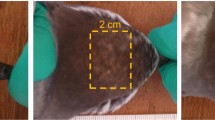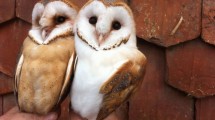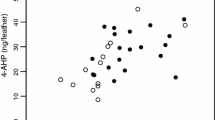Abstract
While the adaptive function of black eumelanin-based coloration is relatively well known, the function of reddish-brown pheomelanin-based coloration is still unclear. Only a few studies have shown or suggested that the degree of reddish-brownness is associated with predator–prey relationships, reproductive parameters, growth rate and immunity. To gain insight into the physiological correlates of melanin-based coloration, I collected barn owl (Tyto alba) cadavers and examined the covariation between this colour trait and ovary size, an organ that increases in size before reproduction. A relationship is expected because melanin-based coloration often covaries with sexual activity. The results showed that reddish-brown juveniles had larger ovaries than whiter juveniles particularly in individuals in poor condition and outside the breeding season, while in birds older than 2 years lightly coloured females had larger ovaries than reddish-brown conspecifics. As barn owls become less reddish-brown between the first and second year of age, the present study suggests that reddish-brown pheomelanic and whitish colorations are associated with juvenile- and adult-specific adaptations, respectively.


Similar content being viewed by others
References
Almasi B, Roulin A, Jenni-Eiermann S, Jenni L (2008) Parental investment and its sensitivity to corticosterone is linked to melanin-based coloration in barn owls. Horm Behav 54:217–223
Amundsen T, Pärn H (2006) Female coloration: review of functional and nonfunctional hypotheses. In: Hill GE, McGraw KJ (eds) Bird coloration, function and evolution. Harvard University Press, Cambridge, pp 280–345
Baag MA, Vassena R, Papasso-Brambilla E, Grupen CG, Armstrong DT, Gandolfi F (2004) Changes in ovarian, follicular, and oocyte morphology immediately after the onset of puberty are not accompanied by an increase in oocyte developmental competence in the pig. Theriogenol 62:1003–1011
Beauchamp G (2003) Delayed maturation in birds in relation to social foraging and breeding competition. Evol Ecol Res 5:589–596
Bókony V, Garamszegi LZ, Hirschenhauser K, Liker A (2008) Testosterone and melanin-based black plumage coloration: a comparative study. Behav Ecol Sociobiol 62:1229–1238
Bubenik GA, Bubenik AB (1985) Seasonal variations in hair pigmentation of white-tailed deer and their relationship to sexual activity and plasma testosterone. J Exp Zool 235:387–395
Budden AE, Dickinson JL (2009) Signals of quality and age: the information content of multiple plumage ornaments in male western bluebirds Sialia mexicana. J Avian Biol 40:18–27
Burley N (1977) Parental investment, mate choice, and mate quality. Proc Natl Acad Sci U S A 74:3476–3479
Caro T (2005) The adaptive significance of coloration in mammals. Bioscience 55:125–136
Ducrest A-L, Keller L, Roulin A (2008) Pleiotropy in the melanocortin system, coloration and behavioural syndromes. Trends Ecol Evol 23:502–510
Dunn PO, Whittingham LA, Freeman-Gallant CR, DeCoste J (2008) Geographic variation in the function of ornaments in the common yellowthroat Geothlypis trichas. J Avian Biol 39:66–72
Ferguson-Lees J, Christie DA (2001) Raptors of the world. Helm Identification Guides. Helm, London
Fox S, Johnson CN, Brooks R, Lewis MJ (2002) Polymorphism, mate choice and sexual selection in the Gouldian finch (Erythrura gouldiae). Aust J Zool 50:125–134
Galeotti P, Sacchi R (2003) Differential parasitaemia in the tawny owl (Strix aluco): effects of colour morphs and habitat. J Zool 261:91–99
Gasparini J, Bize P, Piault R, Wakamatsu K, Blount JD, Ducrest A-L, Roulin A (2009) Strength and cost of an induced immune response are associated with a heritable melanin-based colour trait in female tawny owls. J Anim Ecol 78(3):608–616
Henderson BA, Trivedi T, Collins N (2000) Annual cycle of energy allocation to growth and reproduction of yellow perch. J Fish Biol 57:122–133
Hill GE (1994) Testis mass and subadult plumage in black-headed grosbeaks. Condor 96:626–630
Horseman ND, Smith CA, Culley DD (1978) Effects of age and photoperiod on ovary size and condition in bullfrogs (Rana catesbeiana Shaw) (Amphibia, Anura, Ranidae). J Herpetol 12:287–290
Houtman AM, Falls JB (1994) Negative assortative mating in the white-throated sparrow, Zonotrichia albicollis: the role of mate choice and intra-sexual competition. Anim Behav 48:377–383
Jawor JM, Breitwisch R (2003) Melanin ornaments, honesty, and sexual selection. Auk 120:249–265
Johnstone RA, Reynolds JD, Deutsch JC (1996) Mutual mate choice and sex differences in choosiness. Evolution 50:1382–1391
Kokko H, Johnstone RA (2002) Why is mutual mate choice not the norm? Operational sex ratios, sex roles and the evolution of sexually dimorphic and monomorphic signalling. Phil Trans R Soc Lond B 357:319–330
Kraaijeveld K, Reumer BM (2008) Constraints and the evolution of mutual ornamentation. In: Weber EA, Krause LH (eds) Animal behaviour, new research. Nova, New York
Kraaijeveld K, Kraaijeveld FJL, Komdeur J (2007) The evolution of mutual ornamentation. Anim Behav 74:657–677
Lande R (1987) Genetic correlations between the sexes in the evolution of sexual dimorphism and mating preferences. In: Bradbury JW, Andersson MB (eds) Sexual selection: testing the alternatives. Wiley, London, pp 83–94
Majerus MEN (1998) Melanism, evolution in action. Oxford University Press, Oxford
McGraw KJ (2008) An update on the honesty of melanin-based color signals in birds. Pigment Cell Melanoma Res 21:133–138
Møller AP, Erritzøe J (1988) Badge, body and testes sizes in house sparrow Passer domesticus. Ornis Scand 19:72–73
Nachman MW, Hoekstra HE, D’Agostino SL (2003) The genetic basis of adaptive melanism in pocket mice. Proc Natl Acad Sci U S A 100:5268–5273
Owens IPF, Thompson DBA (1994) Sex differences, sex ratios and sex roles. Proc R Soc Lond B 258:93–99
Piault R, Gasparini J, Bize P, Jenni-Eiermann S, Roulin A (2009) Pheomelanin-based coloration and the ability to cope with variation in food supply and parasitism. Am Nat (in press)
Rohwer S, Fretwell SD, Niles DM (1980) Delayed maturation in passerine plumages and the deceptive acquisition of resources. Am Nat 115:400–437
Roulin A (1999) Nonrandom pairing by male barn owls Tyto alba with respect to a female plumage trait. Behav Ecol 10:688–695
Roulin A (2004) Proximate basis of the covariation between a melanin-based female ornament and offspring quality. Oecologia 140:668–675
Roulin A (2006) Linkage disequilibrium between a melanin-based colour polymorphism and tail length in the barn owl. Biol J Linn Soc 88:475–488
Roulin A (2007) Melanin pigmentation negatively correlates with plumage preening effort in barn owls. Funct Ecol 21:264–271
Roulin A (2009) Covariation between eumelanic pigmentation and body mass only under specific conditions. Naturwissenschaften 96:375–382
Roulin A, Altwegg R (2007) Breeding rate is associated with pheomelanism in male and with eumelanism in female barn owls. Behav Ecol 18:563–570
Roulin A, Dijkstra C (2003) Genetic and environmental components of variation in eumelanin and phaeomelanin sex-traits in the barn owl. Heredity 90:359–364
Roulin A, Wink M (2004) Predator–prey relationships and the evolution of genetic colour polymorphism. Biol J Linn Soc 81:565–578
Roulin A, Richner H, Ducrest A-L (1998) Genetic, environmental and condition-dependent effects on female and male plumage ornamentation. Evolution 52:1451–1460
Roulin A, Jungi TW, Pfister H, Dijkstra C (2000) Female barn owls (Tyto alba) advertise good genes. Proc R Soc Lond B 267:937–941
Roulin A, Riols C, Dijkstra C, Ducrest A-L (2001a) Female- and male-specific signals of quality in the barn owl. J Evol Biol 14:255–267
Roulin A, Riols C, Dijsktra C, Ducrest A-L (2001b) Female plumage spottiness and parasite resistance in the barn owl (Tyto alba). Behav Ecol 12:103–110
Roulin A, Ducrest A-L, Balloux F, Dijkstra C, Riols C (2003) A female melanin-ornament signals offspring fluctuating asymmetry in the barn owl. Proc R Soc Lond B 270:167–171
Roulin A, Bize P, Ravussin P-A, Broch L (2004a) Genetic and environmental effects on the covariation between colour polymorphism and a life-history trait. Evol Ecol Res 6:1253–1260
Roulin A, Müller W, Sasvári L, Dijkstra C, Ducrest A-L, Riols C, Wink M, Lubjuhn T (2004b) Extra-pair paternity, testes size and testosterone level in relation to colour polymorphism in the barn owl Tyto alba. J Avian Biol 35:492–500
Roulin A, Dauwe T, Blust R, Eens M, Beaud M (2006) A link between eumelanism and calcium physiology in the barn owl. Naturwissenschaften 93:426–430
Roulin A, Gasparini J, Bize P, Ritschard M, Richner H (2008) Melanin-based colorations signal strategies to cope with poor and rich environments. Behav Ecol Sociobiol 62:507–519
Sæther BE (1990) Age-specific variation in reproductive performance of birds. Curr Ornithol 7:251–283
Siefferman L, Hill GE (2003) Structural and melanin coloration indicate parental effort and reproductive success in male eastern bluebirds. Behav Ecol 14:855–861
Silva N, Avilés JM, Danchin E, Parejo D (2008) Informative content of multiple plumage-coloured traits in female and male European rollers. Behav Ecol Sociobiol 62:1969–1979
Stelzer C-P (2001) Resource limitation and reproductive effort in a planktonic rotifer. Ecology 82:2521–2533
Studd MV, Robertson RJ (1985) Sexual selection and variation in reproductive strategy in male yellow warblers (Dendroica petechia). Behav Ecol Sociobiol 17:101–109
Taylor IR (1993) Age and sex determination of barn owls Tyto alba alba. Ring Migr 14:94–102
Trouvé S, Jourdane J, Renaud F, Durand P, Morand S (1999) Adaptive sex allocation in a simultaneous hermaphrodite. Evolution 53:1599–1604
Velarde RAM, Wiedenmann RN, Voegtlin DJ (2002) Influence of photoperiod on the overwintering induction of Galerucella calmariensis L. BioControl 47:587–601
Vergara P, Fargallo JA (2007) Delayed plumage maturation in Eurasian kestrels: female mimicry, subordination signalling or both? Anim Behav 74:1505–1513
West PM, Packer C (2002) Sexual selection, temperature, and the lion’s mane. Science 297:1339–1343
Wikelski M, Hau M, Wingfield JC (2000) Seasonality of reproduction in a neotropical rain forest bird. Ecology 81:2458–2472
Wingfield JC, Farner DS (1993) Endocrinology of reproduction in wild species. In: Farner DS, King JR, Parker KC (eds) Avian biology. Academic, London
Acknowledgements
I thank Hughes Baudvin for having organised the collection of dead barn owls along French highways by the SAPRR (Société des Autoroutes Paris-Rhin-Rhône) and the Swiss National Science Foundation (grant PPOOA-102913) for financial support. Ken Kraaijeveld and an anonymous referee kindly provided useful comments to improve the manuscript.
Author information
Authors and Affiliations
Corresponding author
Rights and permissions
About this article
Cite this article
Roulin, A. Melanin-based coloration covaries with ovary size in an age-specific manner in the barn owl. Naturwissenschaften 96, 1177–1184 (2009). https://doi.org/10.1007/s00114-009-0579-9
Received:
Revised:
Accepted:
Published:
Issue Date:
DOI: https://doi.org/10.1007/s00114-009-0579-9




